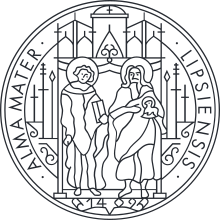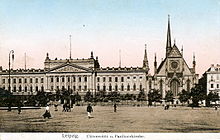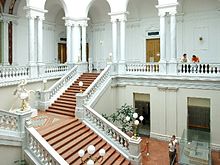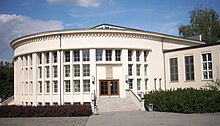Leipzig University
Universität Leipzig | |
 | |
Latin: Alma mater Lipsiensis | |
| Motto | Aus Tradition Grenzen überschreiten |
|---|---|
Motto in English | A tradition of crossing boundaries |
| Type | Public |
| Established | 2 December 1409 |
| Budget | € 408.9 million[1] |
Academic staff | 3,234[1] |
Administrative staff | 1,962[1] |
| Students | 29,459[2] |
| Location | Leipzig , Saxony , Germany |
| Campus | Urban |
| Colours | Red |
| Website | www.uni-leipzig.de |
 | |
Leipzig University (German: Universität Leipzig), in Leipzig in the Free State of Saxony, Germany, is one of the world's oldest universities and the second-oldest university (by consecutive years of existence) in Germany. The university was founded on December 2, 1409 by Frederick I, Elector of Saxony and his brother William II, Margrave of Meissen, and originally comprised the four scholastic faculties. Since its inception, the university has engaged in teaching and research for over 600 years without interruption.
Famous alumni include Leibniz, Goethe, Leopold von Ranke, Friedrich Nietzsche, Robert Schumann, Richard Wagner, Tycho Brahe, Georgius Agricola, Angela Merkel and the nine Nobel laureates associated with the university.
Contents
1 History
1.1 Founding and development until 1900
1.2 Nazi period
1.3 The University under the German Democratic Republic
1.4 After the reunification of Germany
2 Campus
3 Library
4 Faculties
4.1 Institutes affiliated with the university
5 Academics
5.1 Rankings
6 International students
7 Student life
8 People associated with the Leipzig University
9 See also
10 References
11 External links
History
Founding and development until 1900

Leipzig University main building (1917). It was demolished by the socialist administration in 1968.
The university was modelled on the University of Prague, from which the German-speaking faculty members withdrew to Leipzig after the Jan Hus crisis and the Decree of Kutná Hora. The Alma mater Lipsiensis opened in 1409, after it had been officially endorsed by Pope Alexander V in his Bull of Acknowledgment on (September 9 of that year). Its first rector was Johann von Münsterberg. From its foundation, the Paulinerkirche served as the university church. After the Reformation, the church and the monastery buildings were donated to the university in 1544. In order to secure independent and sustainable funding, the university was endowed with the lordship over 9 villages east of Leipzig (university villages). It kept this status for nearly 400 years until landreforms were carried out in the 19th century.
As many European universities, the university of Leipzig was structured into colleges (Collegia) responsible for organising accommodation and collegiate lecturing. Among the colleges of Leipzig were the Small College, the Large College, the Red College (also known as the New College), the College of our Lady and the Pauliner-College. There were also private residential halls (Bursen, see engl. bursaries). The colleges had jurisdiction over their members. The college structure was abandoned later[timeframe?] and today only the names survive.
During the first centuries, the university grew slowly and was a rather regional institution. This changed, however, during the 19th century when the university became a world-class institution of higher education and research.[citation needed] At the end of the 19th century, important scholars such as Bernhard Windscheid (one of the fathers of the German Civil Code) and Wilhelm Ostwald (viewed as a founder of modern physical chemistry) taught at Leipzig.

Formerly organized as a collegiate university, the Red College of Leipzig University was established in the 16th century.
Leipzig University was one of the first German universities to allow women to register as "guest students".[3] At its general assembly in 1873, the Allgemeiner Deutscher Frauenverein thanked the University of Leipzig and Prague for allowing women to attend as guest students.
This was the year that the first woman in Germany obtained her JD, Johanna von Evreinov.
Until the beginning of the Second World War, Leipzig University attracted a number of renowned scholars and later Nobel Prize laureates, including Paul Ehrlich, Felix Bloch, Werner Heisenberg and Sin-Itiro Tomonaga. Many of the university's alumni became important scientists.
Nazi period
Under Nazi rule many Jews' degrees were cancelled;[4] some were later reinstated as Karl-Marx University degrees by the GDR. Noteworthy Nazis, such as Max Clara (chair of anatomy) taught at the university and were appointed to positions with great authority.
The university was kept open throughout World War II, even after the destruction of its buildings. During the war the acting rector, Erich Maschke, described the continuation of the university in a memo on May 11, 1945, announcing the vote for a new rector:
.mw-parser-output .templatequote{overflow:hidden;margin:1em 0;padding:0 40px}.mw-parser-output .templatequote .templatequotecite{line-height:1.5em;text-align:left;padding-left:1.6em;margin-top:0}
Since 4 December 1943 a fixed determination not to abandon the Leipzig University in the most difficult hour of its more than five-hundred-year history has bonded the professors with each other and with the students. The special task of repairing the damage caused by air attacks has now broadened out to the more general duty to save the continuity of our university and preserve its substance, at the very least its indestructible kernel, through the crisis that has now reached its fullest stage. After the destruction of most of the buildings and the majority of its libraries, this kernel is represented by the professoriate alone. This is what must be preserved as the great repository of value in the university.[5]
By the end of the war 60 per cent of the university's buildings and 70 per cent of its books had been destroyed.
The University under the German Democratic Republic
The university reopened after the war on February 5, 1946, but it was affected by the uniformity imposed on social institutions in the Soviet occupation zone. In 1948 the freely elected student council was disbanded and replaced by Free German Youth members. The chairman of the Student Council, Wolfgang Natonek, and other members were arrested and imprisoned, but the university was also a nucleus of resistance. Thus began the Belter group, with flyers for free elections. The head of the group, Herbert Belter, was executed in 1951 in Moscow. The German Democratic Republic was created in 1949, and in 1953 for Karl Marx Year the University was renamed by its government the Karl Marx University, Leipzig after Karl Marx. In 1968, the partly damaged Augusteum, including Johanneum and Albertinum and the intact Paulinerkirche, were demolished to make way for a redevelopment of the university, carried out between 1973 and 1978. The dominant building of the university was the University Tower (now City-Hochhaus Leipzig), built between 1968 and 1972 in the form of an open book.
After the reunification of Germany

Main building of Leipzig University since 2012, the Augusteum at Augustusplatz.

Leipzig's classicist university library, the Bibliotheca Albertina.
In 1991, following the reunification of Germany, the University's name was restored to the original Leipzig University (Alma mater lipsiensis). The reconstruction of the University Library, which was heavily damaged during the war and in the GDR barely secured, was completed in 2002.
With the delivery of the University Tower to a private user, the university was forced to spread some faculties over several locations in the city. It controversially redesigned its historical centre at the Augustusplatz. In 2002, Behet Bonzio received the second prize in the architectural competition; a first prize was not awarded by the jury. A lobby with partial support of the provincial government called for the rebuilding of St. Paul's Church and Augusteum. This caused the resistance of the university leadership, the majority of the students and population of Leipzig. On March 24, 2004 a jury chose a design by Dutch architect Erick van Egeraat, which was well received by almost all parties. He recalls the outer form of the St. Paul's Church (today called Paulinum) and Augusteum, and abstracted the original building complex. Renovations began in the summer of 2005.
In 2008 the university was able to prevail in the nationwide "Initiative of Excellence" of Germany and it was granted the graduate school "BuildMoNa: Leipzig School of Natural Sciences – Building with Molecules and Nano-objects".[6] In addition, the university was able to receive grants from the Saxon excellence initiative for the "Life" project – a project that tries to explore common diseases more effectively. Also in 2008 the "Bach Archive" was associated with the university. In 2009, the Leipzig University celebrated its 600th anniversary with over 300 scientific and cultural lectures and exhibitions,[7] reflecting the role of the university's research and teaching from its beginning.
Campus
The university's urban campus comprises several locations. All in all, the university is spread across 38 locations in Leipzig. The main buildings in the city center are still located on the same land plots as the earliest university buildings in 1409. The university's buildings in the center of Leipzig underwent substantial reconstruction from 2005, the new university's main building being drafted by Dutch architect Erick van Egeraat. The estimated total cost for the renovation project is 140 million euros. The new buildings were scheduled to be completed in 2009/2010, in time for the university's 600th anniversary celebrations.
Besides the faculties and other teaching institutions, several other bodies serve the university: the University Library, a university archive and administration, numerous museums (e.g. the Museum for Music Instruments and the Museum of Ancient Egypt) and the university hospital. The university's Leipzig Botanical Garden, the second-oldest botanical garden in Europe. was established in 1542.
The University's Musical Instrument Museum includes one of the world's three surviving pianos built by Bartolomeo Cristofori, the piano's inventor. Five other Cristofori instruments are included in the Museum's collections.[8]
Key Central institutions[9] of the university are
- Centre for Biotechnology and Biomedicine
- Career Service
- Deutsches Literaturinstitut Leipzig/DLL
- German Centre for Integrative Biodiversity Research (iDiv) Halle-Jena-Leipzig
- Higher Education Didactics Centre Saxony
- Kustodie (Art Collection)
- Leipzig University Music
- Research Academy Leipzig
- Language Centre
- Saxon Preparatory Courses (Studienkolleg Sachsen)
- Translational Centre for Regenerative Medicine Leipzig
- University Archive
- University Library
- University Computer Centre
- Centre for University Sport
- Centre for Teacher Training and School Research
- Centre for Media and Communikation
Library
The University Library of Leipzig was established in 1543. It is one of the oldest German university libraries and it serves as a source of literature and information for the Leipzig University as well as the general public in the region. Its extensive historical and special collections are nationally and internationally recognized. The library consists of the main building "Bibliotheca Albertina" and forty branches situated near their respective academic institutions. The current stock comprises 5 million volumes and about 7,700 periodicals. Collections range from important medieval and modern manuscripts to incunabula, papyri, autographs, ostraka and coins. The Apel Codex, a manuscript of 16th century music, is housed in the Leipzig University library,[10] as well as the Papyrus Ebers.
The Leipzig University Library also owns parts of the Codex Sinaiticus, a Bible manuscript from the 4th century, brought from Sinai in 1843 by Constantin von Tischendorf.[11]Papyrus Ebers is the longest and oldest surviving medical manuscript from ancient Egypt, dated to around 1600 BC.[12]. The Codex contains large parts of the Old Testament and a complete New Testament in ancient Greek, and is one of the most important known manuscripts of the Greek Old Testament and the New Testament. It is the oldest fully preserved copy of the New Testament.
Some of the University Library locations [13] in Leipzig are:
- Bibliotheca Albertina at Beethovenstraße 6
- Campus Library at Universitätsstr. 3
- Library of Deutsches Literaturinstitut at Wächterstr. 34
- Library of Arts at Dittrichring 18–20
- Library of Musicology at Neumarkt 9–19
- Library of Law at Burgstr. 27
- Library of Medicine at Johannisallee 34
- Library of Medicine at Käthe-Kollwitz-Str. 82
- Library of Veterinary Medicine at the Tierkliniken 5
- Library of Biosciences at Talstr. 35
- Library of Chemistry and Physics at Johannisallee 29
- Library of Earth Sciences at Talstr. 35
- Library of Geography at Johannisallee 19
- Library of Archaeology, Prehistory and Ancient History at Ritterstr. 14
- Library of Oriental Studies at Schillerstr. 6
- Library of Sports Science at Jahnallee 59
In addition to the university library, one of the two centers of the German National Library is based at Leipzig, the collections of which are open to use for academic research.
Faculties
The original four facilities were the Faculty of Arts, Theology, Medicine, and Law. Today, the university comprises the following 14 faculties and institutes associated with it.
- Faculty of Theology
- Institute of Old Testament Studies
- Institute of New Testament Studies
- Institute of Church History
- Institute of Systematic Theology
- Institute of Practical Theology
- Institute of Religious Education
- Teaching Unit for Classical Languages
- Liturgical Institute of the VELKD at the Faculty of Theology
- Faculty of Law
- Ernst Jaeger Institute for Corporate Restructuring and Insolvency Law
- Institute for the Legal Profession
- Institute for Labour and Social Law
- Institute for Foreign and European Private and Procedural Law
- Institute for German and International Law of Banking and Capital Markets
- Institute for Broadcasting Law
- Institute for State and Administrative Law
- Institute for Environmental and Planning Law
- Institute for Public International Law, European Law and Foreign Public Law
- Institute for the Foundations of Law
- Faculty of History, Art and Oriental Studies
- Department of History
- Institute of Egyptology
- Institute of Ancient Near Eastern Studies
- Institute of African Studies
- Institute of Anthropology
- Institute for South and Central Asian Studies
- Institute of Oriental Studies
- Institute of East Asian Studies
- Institute for the Study of Religions
- Institute of Classical Archaeology
- Institute of Art History
- Institute of Art Education
- Institute of Musicology
- Institute of Theatre Studies
- Faculty of Philology
- Institute for American Studies
- Institute of Applied Linguistics and Translatology
- Institute of British Studies
- Institute of German Language and Literature
- Herder-Institute (German as a Foreign Language)
- Institute of Classical Studies and Comparative Literature
- Institute of Linguistics
- Institute of Romance Studies
- Institute of Slavonic Studies
- Institute of Sorbian Studies
- Faculty of Education
- Institute of Educational Sciences
- Institute of Pre-Primary and Primary Education
- Institute of Special and Inclusive Education
- Faculty of Social Sciences and Philosophy
- Institute of Communication and Media Studies
- Institute for the Study of Culture
- Institute of Philosophy
- Institute of Political Science
- Institute of Sociology
- Global and European Studies Institute
- Centre for Area Studies (CAS)
- Faculty of Economics and Management Science
- Institute of Empirical Economic Research (IEW)
- Institute of Public Finance and Public Management (PFPM)
- Institute for Theoretical Economics (ITVWL)
- Institute of Accounting, Finance and Taxation (IUFB)
- Institute of Trade and Banking (IHB)
- Institute of Service and Relationship Management (ISRM)
- Information Systems Institute (IWI)
- Institute of Economic Policy (IWP)
- Institute of Business Education and Management Training (IFW)
- Institute of Urban Development and Construction Management (ISB)
- Institute of Real Estate Management (IIM)
- Institute for Infrastructure and Resource Management (IIRM)
- Institute of Building Design and Management (IGB)
- Institute of Insurance Science (IVL)
- Centre for International Economics
- Faculty of Sports Science
- Institute of Sport Psychology and Physical Education
- Institute of Sport Medicine and Prevention
- Institute of Exercise and Public Health
- Institute of General Kinesiology and Athletics Training
- Institute of Movement and Training Science in Sports I
- Institute of Movement and Training Science in Sports II
- Faculty of Medicine (with a University Hospital)
- Institute of Anatomy
- Institute for Social Medicine, Occupational Health and Public Health
- Institute of Biochemistry (medicine)
- Carl Ludwig Institute of Physiology
- Karl-Sudhoff-Institute of History of Medicine and Science
- Clinical Pharmacology
- Institute of Medical Informatics, Statistics and Epidemiology
- Institute for Medical Physics and Biophysics
- Paul Flechsig Institute for Brain Research
- Rudolf Boehm Institute of Pharmacology and Toxicology
- Institute of Legal Medicine
- General Medicine Unit
- Experimental Centre of the Faculty of Medicine
- Interdisciplinary Centre for Clinical Research
- Centre for Clinical Trials Leipzig
- Centre for Environmental Medicine and Environmental Epidemiology
- Innovation Center Computer Assisted Surgery (ICCAS)
- Integrated Research and Treatment Center (IFB) AdiposityDiseases
- LIFE Forschungszentrum für Zivilisationserkrankungen (LIFE)
- Heart Center Leipzig GmbH
- Neurological Rehabilitation Centre
- Faculty of Mathematics and Computer Science
- Institute of Mathematics
- Institute of Computer Science
- Faculty of Biosciences, Pharmacy and Psychology
- Institute of Biology
- Institute of Biochemistry
- Institute of Pharmacy
- Institute of Psychology
- Faculty of Physics and Earth Science
- Institute of Theoretical Physics
- Peter Debye Institute for Soft Matter Physics
- Felix Bloch Institute for Solid State Physics
- Institute for Meteorology
- Institute of Geophysics and Geology
- Institute for Geography
- Didactics of Physics
- Faculty of Chemistry and Mineralogy
- Institute of Analytical Chemistry
- Institute of Inorganic Chemistry
- Institute of Mineralogy, Crystallography and Materials Science
- Institute of Organic Chemistry
- Wilhelm Ostwald Institute of Physical and Theoretical Chemistry
- Institute of Chemical Technology
- Chemistry Didactics
- Institute of Bioanalytical Chemistry
- Faculty of Veterinary Medicine
- Institute of Anatomy, Histology and Embryology
- Institute of Physiology
- Institute of Physiological Chemistry
- Institute of Pharmacology, Pharmacy and Toxicology
- Institute of Animal Nutrition, Nutrition Diseases and Dietetics
- Institute of Virology
- Institute of Immunology
- Institute of Animal Hygiene and Veterinary Public Health
- Institute of Parasitology
- Institute of Bacteriology and Mycology
- Institute of Food Hygiene
- Institute of Pathology
- Department of Small Animal Medicine
- Clinic for Birds and Reptiles
- Large Animal Clinic for Internal Medicine
- Large Animal Clinic for Surgery
- Large Animal Clinic for Theriogenology and Ambulatory Services
- Oberholz Farm for Teaching and Research
Institutes affiliated with the university
- International Max Planck Research School- Mathematics in the Sciences (IMPRS MiS) [14]
- International Max Planck Research School on Neuroscience of Communication: Function, Structure, and Plasticity [15]
- International Max Planck Research School "The Leipzig School of Human Origins" [16]
- Institute of Non-Classical Chemistry e.V [17]
- Institute for Applied Informatics [18]
- Simon Dubnow Institute for Jewish History and Culture at Leipzig University
- Leipzig Centre for the History and Culture of East Central Europe
- Translational Centre for Regenerative Medicine
- German Centre for Integrative Biodiversity Research (iDiv)
- Institute of East Asian Studies of the Leipzig University
- Institute of Classical Archaeology of the Leipzig University
- Institute for International Law, European Law and Foreign Public Law (InVEA) of the Leipzig University
Academics
Today, the university has 14 faculties. With over 29,000 students, it is Saxony's second-largest university. There are now more than 150 institutes and the university offers 190 study programs leading to Bachelor's degrees, Master's degrees, Staatsexamen, Diplom[19] and Ph.D.s.
The university offers a number of courses in English and other foreign languages, and there are several programs which have been specially designed for foreign students. Exchange partner universities include the universities of Arizona, Oklahoma, Houston, Alberta, Ohio, and Edinburgh. Traditionally contacts to universities in Eastern Europe and the Far East are strong as well, e.g. there are cooperations with leading institutions such as Moscow's Lomonosov University and Renmin University in Beijing.

Anatomy auditorium of the Faculty of Medicine
There are several International Master's programs: American Studies, Global Studies, SEPT[20] (MBA in SME Promotion)[21] and one Bachelor/Master's/Ph.D. program (International Physics Studies Program[22]) taught in English. American Studies Leipzig was awarded three international professorships: The Fulbright-Leipzig Chair for American Studies, the DAAD Professorship for American and International Studies, and the Picador Guest Professorship for Literature.[23] It is also the home of Aspeers - Emerging voices in American Studies, a graduate-level peer-reviewed scholarly journal for American studies. Erasmus Mundus Global Studies is an interdisciplinary, research-based Master offered by a consortium of five European universities: Leipzig University, the London School of Economics, University of Vienna, University of Wroclaw and Roskilde University. In the field of anthropology, the university is cooperating with the Leipzig Max Planck Institute for Evolutionary Anthropology. In 1995, the Leibniz-Institute for Jewish History and Culture named after Simon Dubnow was formed as a research institution related to the university. Since 2008 the university is also home to one of Germany's few Confucius Institutes. The Institute is based on an agreement of June 2006 between the university administration and representatives of the Chinese Embassy to establish a Confucius Institute in cooperation with the Renmin University and the "National Office for Teaching Chinese as a Foreign Language". Leipzig University has been the home of the first German chair for Chinese and East Asian Languages in the 19th century, which later became the Institute of East Asian Studies, which still exists today (see Georg von der Gabelentz).
Rankings
University rankings | |
|---|---|
| Global | |
ARWU World[24] | 151-200 |
QS World[25] | 501-550 |
The university is ranked second in Germany, twentieth in Europe, and 105th in the world by the web-based Webometrics Ranking of World Universities, a ranking evaluating universities' scientific online publications. The 2016 ARWU ranking sees Leipzig climbing up to the 151-200 tier being among the top 14 German universities. Leipzig has constantly been ranked among the German top 10 in various university sport disciplines over the past decades.[citation needed]
International students
Leipzig university has a large body of international students. In winter term 2017, out of its 28,797 students about 11% (3,174) were foreign students.[26]
Student life
Leipzig has a thriving student life with a large number of student run bars, sports clubs and recreational facilities for students. The student body in Leipzig is diverse, not only due to the broad spectrum of subjects at the university but also because of the other higher education institutions in the city. The Moritzbastei is the largest student club in Germany, it is part of the historic city fortifications of Leipzig and is famous for its atmosphere and large number of cultural events.
The university is home to the Leipzig Academic Orchestra and the University Choir of Leipzig. There are numerous courses offered in performing arts every semester and a dance festival is organised by students once a year. In the field of sports, the university offers training opportunities and courses in almost all disciplines. During the annual Leipzig book fair, the university library and other university institutions organise public events for authors.
People associated with the Leipzig University

Johann Sebastian Bach

Tycho Brahe

Johann Wolfgang von Goethe

Gottfried Leibniz

Angela Merkel

Friedrich Nietzsche
Leipzig University has produced many notable individuals. Some famous people affiliated with Leipzig include:
Michael Ranft, German historian and theologian.
Johann Christoph Altnickol, German composer, son-in-law to Johann Sebastian Bach
Johann Friedrich Agricola, German composer, pupil of Johann Sebastian Bach
Carl Philipp Emanuel Bach, German composer, second famous son of Johann Sebastian Bach
Johann Christoph Friedrich Bach, German composer, 3rd famous son of Johann Sebastian Bach
Wilhelm Friedemann Bach, German composer, first famous son of Johann Sebastian Bach
Lorenz Christoph Mizler, German composer and music theorist, pupil of Johann Sebastian Bach
Friedrich Blume, German music theorist
Robert Schumann, German music composer
Christoph Graupner, German composer
Johann Kuhnau, German composer, Thomaskantor
Johann David Heinichen, German composer and music theorist, Royal Polish and Electoral Saxon Kapellmeister
Richard Wagner, German composer
Georg Philipp Telemann, German composer, godfather to Carl Philipp Emanuel Bach
Theodor Mommsen, German historian, Nobel Prize in Literature
Franz Delitzsch, German Theologian and Hebrew Scholar
Friedrich Nietzsche, German philosopher
Johann Wolfgang von Goethe, German poet and polymath
Gottfried Wilhelm von Leibniz, German Mathematician who developed calculus, philosopher, polymath
Felix Klein, German mathematician, known for his work in group theory, complex analysis and non-Euclidean geometry
Sophus Lie, Norwegian mathematician who developed Lie Algebra
Johann Heinrich Winckler, German Physicist
Werner Heisenberg, German physicist, Nobel Prize in Physics
Felix Bloch, Swiss physicist, Nobel Prize in Physics
Friedrich Hund, German physicist, discovered quantum tunnelling and is known for Hund's rules
Julius Edgar Lilienfeld, Austro-Hungarian Physicist
Ludwig Boltzmann, Austrian physicist
Tycho Brahe,[27] Danish astronomer
Gustav Hertz, German physicist, Nobel Prize in Physics
Sin-Itiro Tomonaga, Japanese physicist, Nobel Prize in Physics
William Vermillion Houston, American physicist
Edward Teller, Hungaro-American nuclear scientist, member of the Manhattan Project
Bartel Leendert van der Waerden, Dutch mathematician
Edgar Odell Lovett, American mathematician
Peter Debye, Dutch-American physicist and chemist, Nobel Prize in Chemistry
Wilhelm Ostwald, German chemist, Nobel Prize in Chemistry
Paul Ehrlich, German doctor, Nobel Prize in Medicine
Gustav Theodor Fechner, German psychologist, founder of Psychophysics
Maximilian von Frey, physiologist, inventor of the esthesiometer
Ernst Heinrich Weber, German physician and professor whose studies paved the way for the founding of Psychology
Wilhelm Wundt, German psychologist, founded the first formal laboratory for psychological research
Friedrich Trendelenburg, German surgeon, described surgical removal of pulmonary emboli[28]
Hans-Georg Gadamer, German philosopher and rector of the university
Johann Christoph Gottsched, German poet, author, and critic
Christian Friedrich Henrici, German poet, Saxon Actuary, Postal clerk, Postal Commissioner, and Wine inspector
Gotthold Ephraim Lessing, German philosopher and writer
Lin Yutang, Chinese author and linguist
Luo Gan, Chinese Politician, Member of the Politburo Standing Committee
Johann Major, German Lutheran theologian, a principal author of the so-called Leipzig Interim, and author of the Majoristic Controversy
Angela Merkel, first female German Chancellor
Hans-Dietrich Genscher, German politician, Foreign Minister and Vice Chancellor
Ferdinand de Saussure, linguist, founder of structuralism
Rudolph Sohm, lawyer and Church historian
Nathan Söderblom, Swedish clergyman, Nobel Peace Prize
C. F. W. Walther, first President of the Lutheran Church–Missouri Synod and its most influential theologian.
Cai Yuanpei, president of Peking University and leading thinker in the early Chinese communist movement
Michelle Bachelet, first female President of Chile between 2006 and 2010
Raila Odinga,Kenya's second Prime Minister and the father of Africa's modern democracy.
Luz Long, German Olympic long-jumper, noted for his sportsmanship
See also
- Handelshochschule Leipzig (HHL)
- Leipzig school (sociology)
- List of medieval universities
- List of universities in Germany
- Nobel laureates by university affiliation
References
This article has an unclear citation style. (March 2015) (Learn how and when to remove this template message) |
^ abc "Jahresbericht 2015" (PDF). Leipzig University (in German). pp. 53–59. Retrieved 2017-06-18..mw-parser-output cite.citation{font-style:inherit}.mw-parser-output .citation q{quotes:"""""""'""'"}.mw-parser-output .citation .cs1-lock-free a{background:url("//upload.wikimedia.org/wikipedia/commons/thumb/6/65/Lock-green.svg/9px-Lock-green.svg.png")no-repeat;background-position:right .1em center}.mw-parser-output .citation .cs1-lock-limited a,.mw-parser-output .citation .cs1-lock-registration a{background:url("//upload.wikimedia.org/wikipedia/commons/thumb/d/d6/Lock-gray-alt-2.svg/9px-Lock-gray-alt-2.svg.png")no-repeat;background-position:right .1em center}.mw-parser-output .citation .cs1-lock-subscription a{background:url("//upload.wikimedia.org/wikipedia/commons/thumb/a/aa/Lock-red-alt-2.svg/9px-Lock-red-alt-2.svg.png")no-repeat;background-position:right .1em center}.mw-parser-output .cs1-subscription,.mw-parser-output .cs1-registration{color:#555}.mw-parser-output .cs1-subscription span,.mw-parser-output .cs1-registration span{border-bottom:1px dotted;cursor:help}.mw-parser-output .cs1-ws-icon a{background:url("//upload.wikimedia.org/wikipedia/commons/thumb/4/4c/Wikisource-logo.svg/12px-Wikisource-logo.svg.png")no-repeat;background-position:right .1em center}.mw-parser-output code.cs1-code{color:inherit;background:inherit;border:inherit;padding:inherit}.mw-parser-output .cs1-hidden-error{display:none;font-size:100%}.mw-parser-output .cs1-visible-error{font-size:100%}.mw-parser-output .cs1-maint{display:none;color:#33aa33;margin-left:0.3em}.mw-parser-output .cs1-subscription,.mw-parser-output .cs1-registration,.mw-parser-output .cs1-format{font-size:95%}.mw-parser-output .cs1-kern-left,.mw-parser-output .cs1-kern-wl-left{padding-left:0.2em}.mw-parser-output .cs1-kern-right,.mw-parser-output .cs1-kern-wl-right{padding-right:0.2em}
^ "Zahlen und Fakten". Leipzig University (in German). Retrieved 2017-06-18.
^ MargritTwellmann, Wolfgang Abendroth, ed. (1972). "Louise Otto Peters. Das erste Vierteljahrhundert. S. 30". Die deutsche Frauenbewegung1843-1889 (Marburger Abhandlungen zur Politischen Wissenschaft)|format=requires|url=(help) (in German) (1 ed.). Berlin: Hain. p. 112."Auf der Generalversammlung des Allgemeinen deutschen Frauenvereins 1873 dankt eine Referentin den Universitäten in Leipzig und Prag für die Zulassung der Frauen als Gasthörerinnen.
|access-date=requires|url=(help)
^ "A Jewish Palestinian's quest to receive his degree, from Nazi Germany". wn.com. Retrieved December 31, 2013.
^ Universitätsarchiv Leipzig, Rectorate 50. Quoted in Grondin, Jean (2003). Hans-Georg Gadamer: A Biography. New Haven: Yale University Press. p. 234. ISBN 0-300-09841-3.
^ Dr. Alexander Weber (May 17, 2013). "Graduate School BuildMoNa". Buildmona.de. Retrieved December 31, 2013.
^ Universität Leipzig 600th Anniversary Archived July 19, 2011, at the Wayback Machine
^ Museum of Musical Instruments Archived September 25, 2008, at the Wayback Machine
^ Leipzig, Universität. "Universität Leipzig: Central Institutions". www.uni-leipzig.de.
^ Sadie, Stanley; Latham, Alison (1994). "The Grove Concise Dictionary of Music". Missing or empty|url=(help)
^ Aland, Kurt; Aland, Barbara (1995). The Text of the New Testament: An Introduction to the Critical Editions and to the Theory and Practice of Modern Textual Criticism. Erroll F. Rhodes (trans.). Grand Rapids, Michigan: William B. Eerdmans Publishing Company. pp. 107–108. ISBN 978-0-8028-4098-1.
^ "In Pursuit Of Knowledge - An Exhibition of Leipzig University Library -". www.inpursuitofknowledge.org.
^ "Universitätsbibliothek Leipzig: Locations". www.ub.uni-leipzig.de.
^ "Graduate School". www.imprs-mis.mpg.de.
^ "About Us". imprs-neurocom.mpg.de.
^ Leipzig, International Max Planck Research School: The Leipzig School of Human Origins,. "IMPRS "The Leipzig School of Human Origins" - Home". www.leipzig-school.eva.mpg.de.
^ http://www.uni-leipzig.de/fileadmin/user_upload/Forschung/research_academy/Promotion_UL/Promotionsleitfaden_2016.pdf
^ http://www.infai.org
^ Since the adoption of the Bachelor's degree and Master's degree only three study programs leading to Diplom have remained: Maths, Mathematical economics and Protestant Christian Theology.
^ SEPT, the international Program of the University of Leipzig for Small and Medium-Sized Enterprise promotion and training http://www.sept.uni-leipzig.de/
^ "SEPT – MBA program at glance". Sept.uni-leipzig.de. Archived from the original on October 14, 2007. Retrieved December 31, 2013.
^ "Homepage of the International Physics Studies Program at Leipzig". Uni-leipzig.de. Archived from the original on February 12, 2012. Retrieved December 31, 2013.
^ "The Picador Guest Professorship for Literature | American Studies Leipzig". Americanstudies.uni-leipzig.de. Retrieved December 31, 2013.
^ "ARWU World University Rankings 2017 - Academic Ranking of World Universities 2017 - Top 500 universities - Shanghai Ranking - 2017". www.shanghairanking.com.
^ "QS World University Rankings 2018". February 1, 2017.
^ "Statistical Office of Saxony, Statistical data of June 2018 for academic winter term 2017" (PDF).
^ John Louis Emil Dreyer, Tycho Brahe: a Picture of Scientific Life and Work in the Sixteenth Century, Cambridge UP (2014 [1890]), p. 16.
^ Arch Klin Chir 86:686, 2908, 1908
External links
| Wikimedia Commons has media related to Universität Leipzig. |
- Leipzig University Website
- History of the Leipzig University (English, German)
 Herbermann, Charles, ed. (1913). . Catholic Encyclopedia. New York: Robert Appleton Company.
Herbermann, Charles, ed. (1913). . Catholic Encyclopedia. New York: Robert Appleton Company.
Coordinates: 51°20′20″N 12°22′43″E / 51.33889°N 12.37861°E / 51.33889; 12.37861
